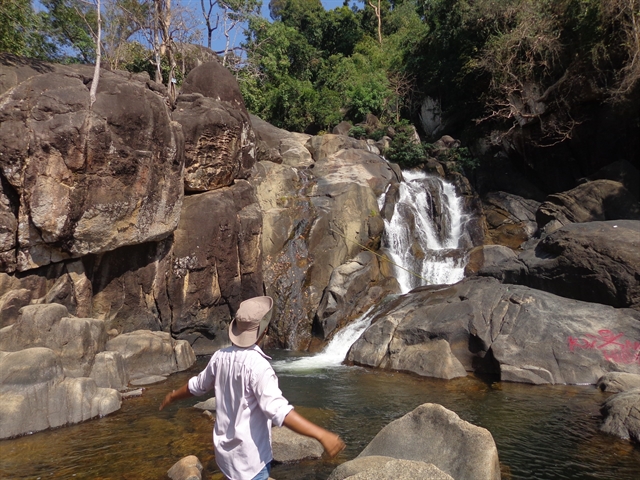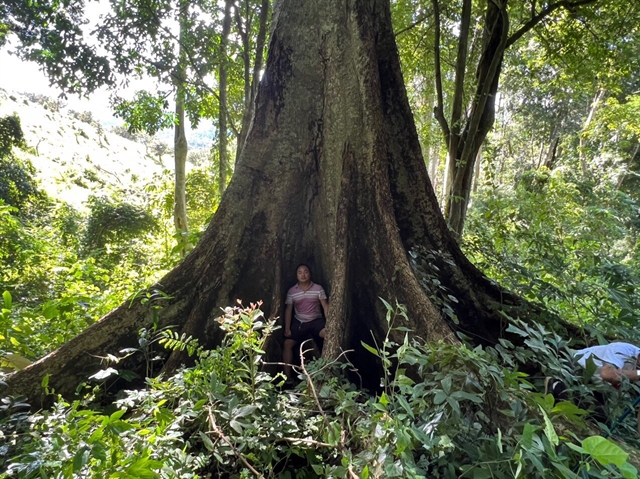 Opinion
Opinion

 |
| Our Lady Waterfall, located within the Núi Ông Natural Reserve, is surrounded by a forest that may be transformed into the Ka Pét Reservoir. Photo Nguyễn Hoàng Nam |
by Phạm Văn Thế, Phùng Mỹ Trung et al.*
The Environmental Impact Assessment (EIA) Report of the Kapet Reservoir in South Hàm Thuận District, Bình Thuận Province, was uploaded to the website of the Ministry of Environment and Natural Resources, prepared by the Bình Thuận People’s Committee on July 19, 2023. In the report, there are many points that have not been seriously considered, such as a few issues pointed out below.
The current forest status in the future Kapet Reservoir is not poor according to wood volume
The total natural wood volume in the forest, according to the EIA report, is 91,251.1 cubic metres (p114). If we divide this by the total natural forest area of 612.48 ha, then the average wood volume is 158.8 cubic metres per hectare. According to Article No. 7, Circular No. 33/2018/TT-BNNPTNT by the Ministry of Agriculture and Rural Development titled “Regulations on forest inspection, calculation, and supervision”, a forest with a wood volume between 100 and 200 cubic metres per hectare is termed an “Average Forest” (compared with Rich or Poor forest). This categorises the planned forest for the Kapet Reservoir as an “Average Forest” (not a Poor Forest as shown in the report).
However, the EIA report made a mistake when it classified forests, confusing different types. The forest classification has been clearly stated in Articles 4, 5, 6, and 7 of the aforementioned Circular No. 33 in 2018 by the Ministry of Agriculture and Rural Development, Việt Nam. A forest should be classified by the following categories and should not be mixed up: (1) according to wood volume, (2) according to dominant species, (3) according to site conditions, and (4) according to origin of formation.
These mistakes may be due to a lack of expertise by environmental impact assessors or deliberate ambiguity to reduce the severity of the problem.
Biodiversity was not carefully evaluated
In the expansive forest area, only 78 wood species have been identified. Moreover, 79 amphibian reptiles, 77 bird species, 6 animal species, and 11 fish species have been documented. The findings of this investigation seem superficial and negligent.
The biodiversity assessment survey seems not to have been conducted by experts, but rather by individuals lacking the necessary qualifications. The entire section on animals was condensed into a single page (page 117), insufficient to provide any detailed species data. Notably absent was a list of species, especially a roster of rare and threatened species that should be prioritised for conservation and protection. Due to the absence of this list, errors in species names cannot be identified. For instance, the species Melanorrhoea usitata Wall. is now recognised as a synonym for the species Gluta usitata (Wall.) Ding Hou. While the EIA report lists the Anseriformes Order as having 48 species in the project area, only 22 species are currently recorded in Vietnam. Remarkably, scientists are poised to announce at least one new reptile and one new amphibian species from this area in 2024, but these are not mentioned in the report.
In nature, insects represent nearly 90 percent of all species on earth. Yet, the EIA report for this region entirely omits any information on insects. Another glaring omission is the lack of data on soil animals, despite their pivotal role in the forest ecosystem.
Methods required to minimise the impacts on the biodiversity of Núi Ông Nature Reserve
The Kapet Reservoir Project, if undertaken, will cover 149.09ha of protected forest in sub-zones 252 and 262 of the Núi Ông Natural Reserves. Within the project's confines, 2 plant species and 10 animal species have been identified, all of which are featured in Việt Nam’s Red Book of Endangered Species (2007 edition). Additionally, 10 species are on the CITES listing, and 8 species fall under the government’s resolution No. 32/2006/NĐ-CP.
Lưu Hồng Trường et al. (2010) note that the Núi Ông Natural Reserves contain 763 vascular plant species. Among these, 55 are endangered either nationally or internationally. The Nature Reserve also houses 83 animal species, 165 bird species, 46 reptile species, and 20 frog species. Within the globally endangered categories, 25 animal species, 6 birds, 6 reptiles, and 3 frog species are included. Nationally endangered species comprise 32 animal species, 8 birds, and 14 reptile species.
On pp 129-130, the EIA report articulates: “Natural forests are indispensable for environmental ecology, biodiversity, water resource conservation, and local climate moderation. The permanent change in land use, transitioning from natural forests for diverse purposes, will reduce the national expanse of natural forests and fracture natural ecological systems (habitats, feeding paths for all biological organisms in the vicinity). This notably modifies the living environments of wild animals and species. Moreover, it provides access for local or forest poachers to the heart of natural forests and allows construction personnel to penetrate protected zones. In the long run, the depletion of natural forests can lead to severe repercussions. Natural calamities such as flash floods, soil erosion, droughts, and saline intrusion can all be linked to forest degradation.”
While the report recognises the dire consequences of depleting natural forests, especially in the Nature Reserve where many species receive legal protection, it fails to propose any strategies to alleviate or curtail these effects.
 |
| A lone false white teak tree (tetrameles nudiflora) stands in a forest near the proposed Ka Pét Reservoir. This species is commonly found in teak forests at elevations of up to 500m but can sometimes be seen at altitudes reaching 1,000m. Photo Phạm Văn Hiếu |
Carbon Storage and Emissions Post-Project Completion
Another pivotal element that the EIA report neglected is the carbon storage potential and subsequent emissions of Carbon Dioxide (CO2) and Methane (CH4) upon forest degradation.
Based on findings by Phạm TT et al. (2022), the average carbon stored by “Average Forests” in Vietnam ranges from 100.10 – 155.49 tonnes per hectare. As a result, an area spanning 612.48 hectares of natural forest in the prospective Kapet Reservoir Project could sequester between 61,309 – 95,234 tonnes of carbon. Simultaneously, vast amounts, reaching up to millions of tonnes, of CO2 and CH4 are expected to be released into the atmosphere.
When a forest is demolished, components like branches, leaves, roots, and tree trunks start decomposing, thereby emitting CO2. Specifically, plant matter submerged underwater will release significant amounts of CH4. New forests cannot compensate for this loss as carbon storage capability is contingent upon the forest's woody biomass. Essentially, we risk forfeiting our carbon storage credits whilst concurrently propelling the forestry sector towards a net carbon-positive trajectory. (One carbon credit corresponds to a forest's storage of one tonne of carbon. Industries emitting more carbon than they sequester are dubbed as carbon-positive, and the reverse is true).
Considering the aforementioned issues, it begs the question: is razing the entirety of the forest to establish a reservoir truly justified?
Furthermore, the forested area designated for the Kapet Lake has suffered significant degradation over the years. Fragmentation has disrupted geographical regions, habitats, and the ecological balance of numerous species. The extant forests in Việt Nam remain our sole hope to salvage and rejuvenate these fragile ecosystems. Once the forest is cleared and the reservoir completed, annual rainfall will erode the topsoil, which will subsequently accumulate in the reservoir, reducing its water storage capacity annually. Will the revenue generated from agriculture and industrial crops suffice to offset the costs of annual sediment dredging?
Such economic-environmental dilemmas warrant careful contemplation before we incur the irrevocable costs of deforestation. VNS
*Dr Phạm Văn Thế is a distinguished biologist who pursued his training and conducts his research in Việt Nam. He holds the distinction of having over 20 species discoveries to his name, with three of these newly identified species being named in his honour.
Phùng Mỹ Trung is a dedicated biodiversity researcher. He has founded a vast network that encompasses thousands of households throughout Việt Nam. His commendable initiative is centred on enlightening the younger generation about the importance of biodiversity and the vital need for forest conservation.